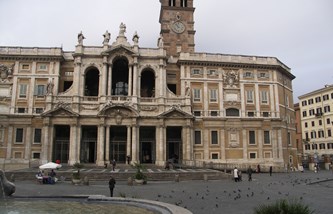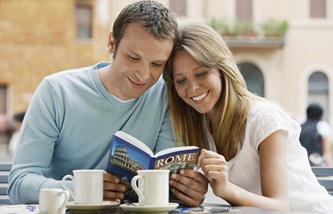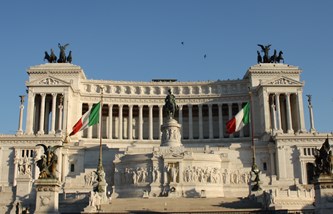Tours

Rome Tourist Card
Rome Tourist Card
Snap up the Rome Tourist Card and you'll get everything you need to explore Rome's top highlights including Colosseum, Palatine Hill, Roman Forum and Hop on/off bus. You can even choose the order you see things in.

Colosseum, Roman Forum & Palatine Hill: Priority Entrance
Colosseum, Roman Forum & Palatine Hill: Priority Entrance
Skip the long lines at the Colosseum with this priority-entrance ticket. This ticket will let you bypass the crowds. And after exploring the Colosseum you can head to the area of the Roman Forum and the Palatine Hill.
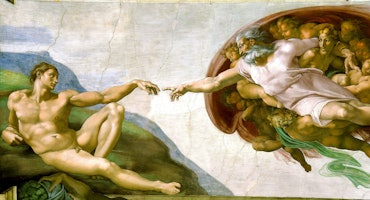
Vatican Museums & Sistine Chapel: Skip The Line
Vatican Museums & Sistine Chapel: Skip The Line
This ticket will make you save stress and time by allowing you to get priority entrance and skip the line. Visit the the countless masterpieces by Michelangelo, Raphael, Caravaggio, Tiziano and the Sistine chapel.
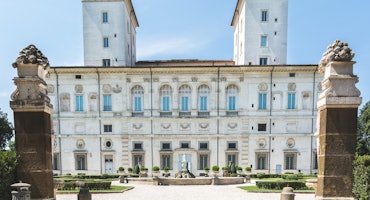
Borghese Gallery: Fast Track
Borghese Gallery: Fast Track
Galleria Borghese is located in the villa of the park Villa Borghese. Admire the architecture and furnishings of this beautiful villa. It is a museum full of art from the Renaissance. The collection includes several sculptures and paintings. Because of limited capacity get tickets for this museum weeks in advance.
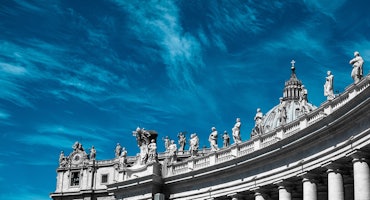
St. Peter’s Basilica: Dome Climb with Guide
St. Peter’s Basilica: Dome Climb with Guide
Get the most out of your visit to St. Peters with a guided tour to climb the basilica’s dome designed by Michelangelo and admire one of the stunning view. After the tour, you can explore the the basilica at your own pace.
Basilica of San Clemente
Just a few meters away from the Colosseum, you have the chance to take a fascinating journey through history. The church of San Clement, with its complex underground layers, is a real “time machine” which will give you the opportunity to discover many secrets of the last 2000 years of history.
For 300 years now, the church has been a convent of Irish Dominican friars, who have greatly contributed to bring back to light some unique remains of an antique past. Over the many examples of “layered” worship sites, this is probably the most famous one. Also, these subterranean halls preserve the very first evidence of the early Italian language, in an inscription which shows something very different from the courtly lexical elegance of Latin. We’ll begin our journey from the bottom, more than 10 meters below the ground, at a time when the site was not even consecrated to Christ.
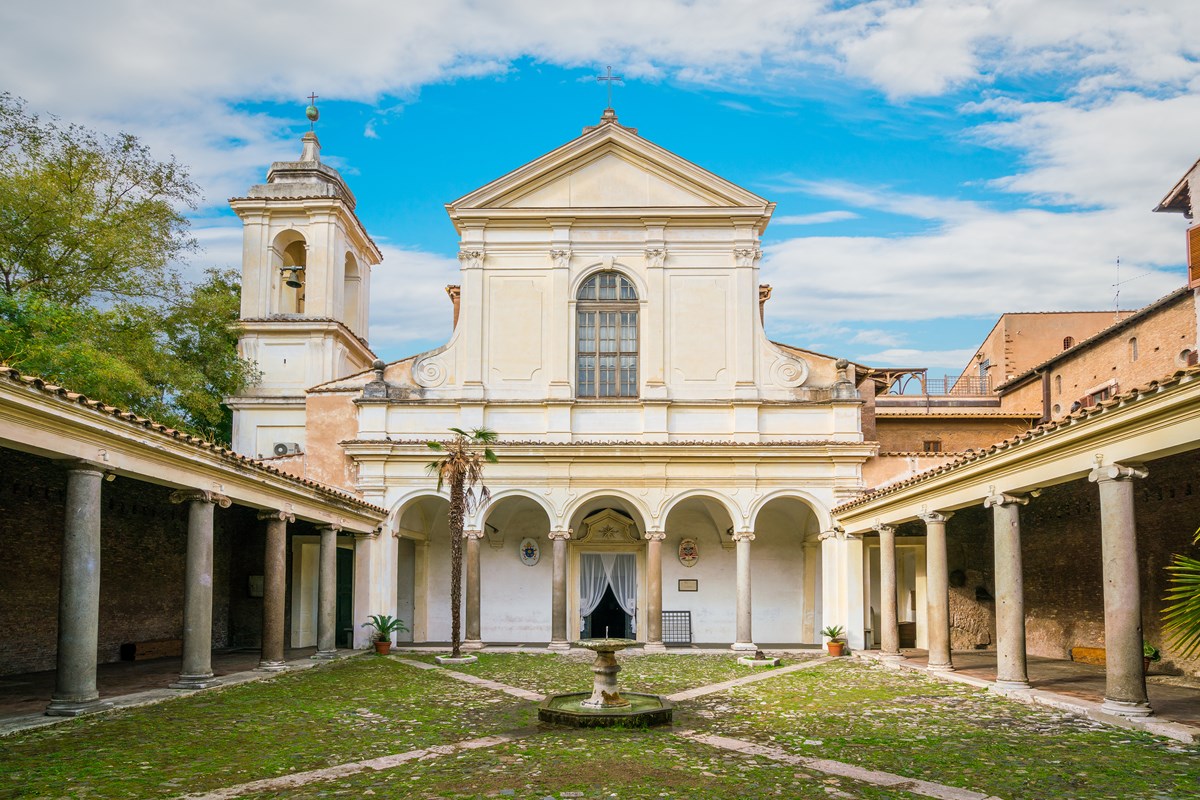
The Lower Temple and Roman Domus
Two levels under the ground, we find the well preserved remains of a pagan temple and also a Roman house, a “domus”. Actually the latest archaeological findings have confirmed that the base of the site probably belongs to the upper ceiling of a Roman building that was destroyed during the great fire of 64 AD. This area was part of the large Nero’s estate, which included the famous Domus Aurea, his private and luxurious residence. After Nero’s death, his great palace was demolished and the whole area was reorganized. A few meters away, the new emperor decided to create one of the largest arenas of the ancient world (the Colosseum) whilst the Empire's mint was probably located here. Just beside it, there was a private patrician home, a domus. And the remains are clearly visible: you can see some of the rooms, with frescoed walls and stucco decorations on the ceilings.
From the third century, a new cult arrived in Rome, and it slowly gained followers. The house was converted into a temple for the new religion, the Mithraic cult. Mithra was a deity belonging to the Persian tradition of the so-called mystery cults. The worshippers were men only and there were seven levels of initiation. The temple, called “mithreum”, is a cave-like room. Mithra was believed to be born from a rock and, by the will of Apollo, he was committed to redeeming humankind. In this mithreum you can see an ancient altar with a sculpture of Mithra killing a bull. A hundred years later, Christianity was the official religion of the Empire. The temple was abandoned and the whole area became the foundation of a new church.
The First Church dedicated to San Clement
We now have to rise up one level, to enter the amazing remains of the first basilica, a church built in the V century AD in honor of Clement, who was the third pope in line after Peter, in the II century. At those times, Christians were still actively persecuted. Clement was sentenced to hard labor, exiled in Crimea, but that didn’t stop him continuing to convert his fellow prisoners. For this reason, he was sentenced to death: he was tied to an anchor and thrown into the Black Sea.
The structure of this underground church features porticoes and colonnades. Some of the upper parts have been incorporated in the church above. This basilica has been used for more than seven centuries, and bears the legacy of artistic and architectural development during the different times. For example, you can admire a mosaic floor created with many tiny pieces of colored marble. Each type of marble comes from a different part of the countries overlooking the Mediterranean sea, to testify the spread of the Christian religion across the known world.
On a wall, there is a unique fresco of the Holy Mary dated VIII century. One of the chapels is dedicated to the inventor of the Cyrillic alphabet, St. Cyril. His tomb, dated IX century, is still well preserved, together with a painting depicting the saint.
The excavation works are still in process and continue to reveal new and interesting memories of the past. To preserve this site there are sensors that record the levels of humidity and the variations in temperature.
In recent years, a 4 meter diameter marble baptismal font has been discovered. Also, there are the remains of a sacristy that was used by the popes while they visited all the Roman basilicas during the Lenten season. When Rome experienced the troubled barbaric invasions, especially the ones of the Norsemen, there was instability on a social and political level. Some of the areas of this church were converted into a cemetery, and we can even see some tombs carved into the walls. The tall skeleton found in one of these burial places probably belonged to a Norseman.
Those warring armies arrived in Rome in 1084 following the request of Pope Gregory VII who wanted to be freed from the siege of the German troops under the command of the Emperor Henry IV. But, once the Norsemen defeated the Imperial army, they extensively sacked the city. Still, they where, after all, already converted to Christianity, so they used this site as burial grounds.
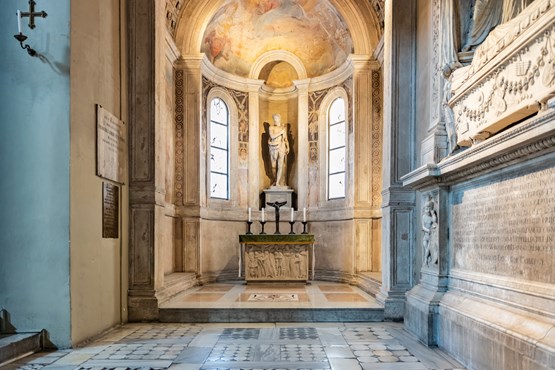
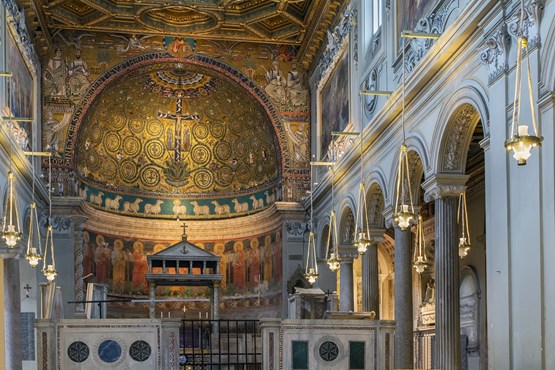
The Upper Basilica: A Romanic Jewel
You are now at ground level and you are probably wondering why the second (and last) church was built “on top” of the older one. Why didn’t they simply renovate the first one? The reason can be found in the peculiar morphology of the area. This is a valley between two hills, and, as centuries passed, it was slowly filled with sediments. Centuries ago, the ground level was in the Roman domus where you first started your visit, two levels below.
In the year 1100, Pope Pascal II decided to rebuild the church, which had suffered from the looting of the Barbarians and was probably largely damaged. The upper basilica is a masterpiece of Christian art. Some of the most valuable “pieces” of the lower church were moved here. Pascal, a Benedictine monk, was nominated pope in this very place, in a time when there were bitter struggles between the papacy and the empire, and the most influential families of the Roman aristocracy kept backing one faction or the other, depending on their political interests. Pascal wanted to give a clear sign that the Papal power (both spiritual and secular) was stronger than the German Empire, and that’s why he decided to renovate many churches in Rome. His inspiration was the Benedictine monasteries, places of prayer and recollection.
San Clement, with its rigorous Romanesque architecture, later enriched with a Baroque touch, is a powerful example of the ideals brought forward by the highest representatives of Christianity during the Middle Ages.
Just outside the church, there is a four-sided portico. The facade and the bell tower were designed in the XVIII century by Carlo Stefano Fontana, the nephew of Carlo Fontana (St. Peter’s Baptismal font, the Montecitorio Palace – house of the parliament).
The basilica has three naves with ancient columns. The floor is in Cosmatesque style. The Cosmati masters were a Roman family of marble workers who had various workshops around town. For four generations, between the XII and the XIII centuries, they worked in many churches, creating mosaics, statues and decorations. Their “signature” works included elaborated mosaics created with marble and glass.
What To See in the Church
Inside, the church shows a three nave structure. Its Romanesque architecture has been altered with later Baroque decorations, and in general the church bears the artistic “signs” of its many centuries of existence. Among the many masterpieces here’s what you can’t miss.
THE MOSAIC OF THE APSE – This stunning example of Middle Age mosaic is incredibly well preserved. Its design, is a metaphor of the life-giving force of the New Testament. In the middle there is a Crucified Jesus, between the Holy Mary and St. John the Evangelist. The entire scene is dominated by spirals of sprouting vines: the message of the Gospel has the power to bring the Church back to life, and it’s the sacrifice of Christ that has made this possible. The doves around Christ symbolize the twelve apostles. The style of this shiny mosaic has something in common with the artistic taste of the more ancient Roman mosaic, especially in the imaginative way of depicting small details, such as the flowers adorning the vines.
THE SCHOLA CANTORUM – Since the beginning of the Roman liturgy, sacred hymns were part of the celebrations. The psalmist and singers were placed in a precinct, erected at the end of the central nave of the church. In particular, the psalmists chanted the first verse of the psalms, and the parishioners responded with the other part. The Schola Cantorum that you see here was made using many fragments of the much older one which was placed in the lower basilica.
At the beginning of the first left nave, there’s a chapel dedicated to Saint Catherine of Alexandria, decorated with frescoes of the artists Masolino da Panicale and Masaccio.
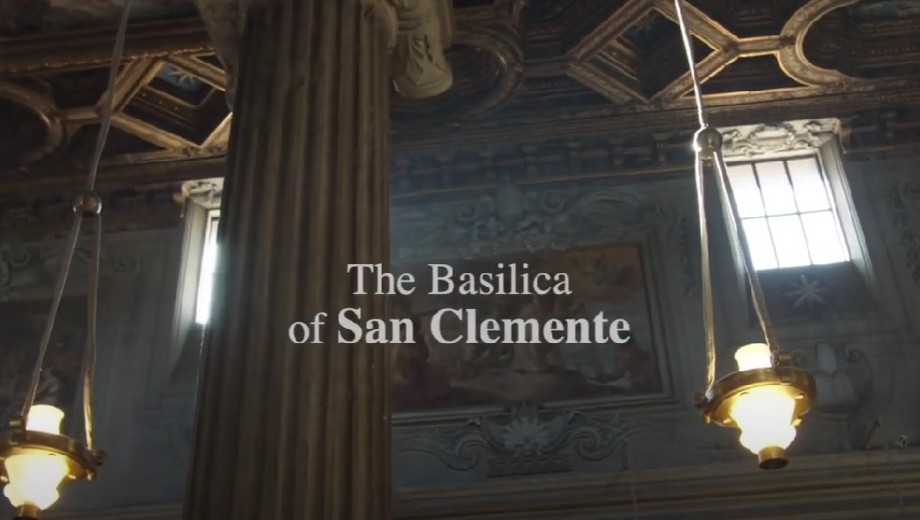
Latin vs Italian: the Saint against the Prefect
Hidden in the fresh and artificially lit halls of the first basilica, there is a fresco that not only tells a story, but it is also the first “document” which involves the use of an early version of the Italian language. In the V century, when the first church was built, Latin was the official language of the Empire and then of the Papal State. Italian was only spoken by commoners and wasn’t present in any official inscription or spoken during official ceremonies or events.
The fresco, called Giudizio Particolare (Particular Judgement) tells the legend about an episode of the life of St. Clement. The wife of Sisinno, the prefect of Rome, was secretly a Christian. One day, her husband, with some of his slaves, followed her, and found the lady attending a mass celebrated by Clement. He was furious, and ordered his slaves to capture Clement. As per divine intervention, he and his slaves were temporarily blinded. They mistook the pope for one of the columns in the hall, finding it of course very hard to move it and take it with them. In the inscription, Sisinno urges his servants to capture the “pope”, using a very colorful expression indeed, which is written in Italian. In the same fresco there are some words in Latin, attributed to Clement.
The use of the two languages was to show the different cultural level of Clement, who spoke Latin, and Sisinno, who could only express himself in a lower-level language and, on top of that, using swear words! Italian became fully developed with its grammar, syntax and lexical complexity, only around the XIII century. In the beginning, the Italian language was called “Volgare”, which means “belonging to the common people”. It has to be noted that, in Italian, the adjective “volgare” (vulgar) has, a definite negative connotation in today’s language.
Travel Tips and How to Get To San Clement
The church is open from Monday to Saturday in the following hours: 09.00-12.30 and 15.00 -18.00. On Sundays and on public holidays, it’s open from 12.00 to 18.00. As in every church in Rome, you should not enter with bare shoulders or shorts. Also, it is advisable to switch off your phone while you are inside. The whole site, including the lower levels, is equipped with a video surveillance system, for the safety of the pilgrims and the visitors. It’s forbidden to take pictures or videos in the archaeological area.
Due to Covid-19 restrictions and protocols, it is necessary to book your visit to the church in advance, to secure your place in the hours and dates of your interest. You can check prices and availability on this page here.
You can arrive here with the subway, Metro Line B (metro stop Colosseo) and walk for about 10 minutes on the road called Via San Giovanni in Laterano. From St. Peter’s, you can catch the bus 571 and disembark at the second stop after the Colosseum. Otherwise, if you are coming from Venice Square, you can catch bus 85 or 850 for 5 stops and you’ll arrive approximately 50 meters from the church’s entrance. The address of San Clemente is Via Labicana 95.

